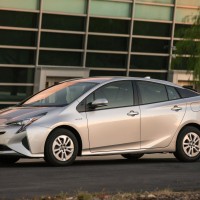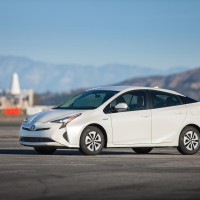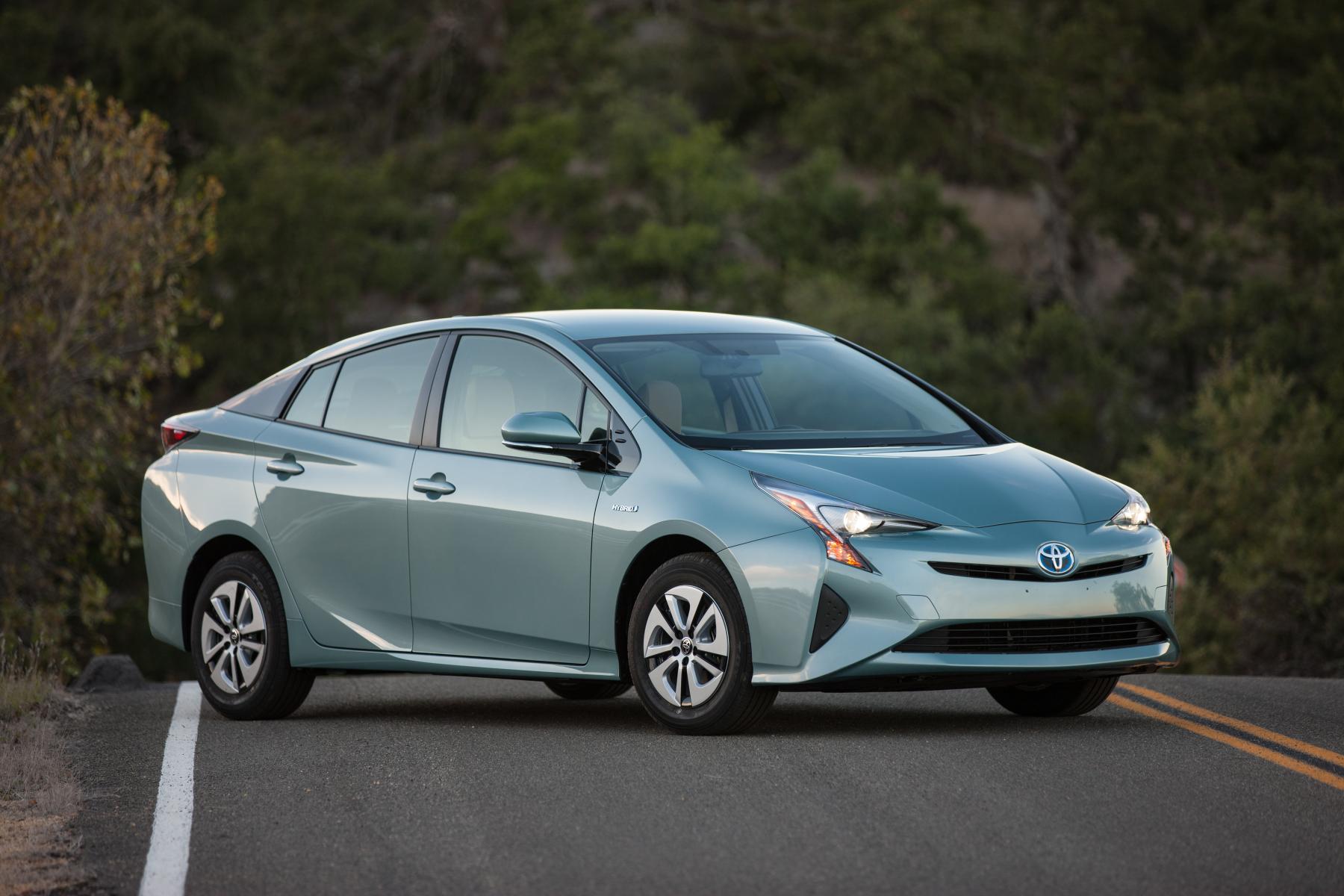
- Striking exterior design ushers in new hybrid era
- New hybrid system with notable fuel economy boost
- New platform with double wishbone rear suspension dials up driving dynamics
- First vehicle based on Toyota’s New Global Architecture
- Available Toyota Safety Sense system with automatic pre-collision braking
The 2016 Prius is anticipating fuel economy ratings of 54 MPG city / 50 MPG highway / 52 MPG combined (Final EPA figures pending.). That’s better than any mass-produced passenger vehicle available without a plug. And, as before, the Prius sips regular-grade gasoline. A new Eco grade model is expecting ratings of 58 MPG city / 53 MPG highway / 56 MPG combined thanks to lighter weight and further optimized aerodynamics.
The new Prius’ premium interior debuts advanced technology complemented by features that are functional, fun and also delight the eyes. The wrap-around dash design, form-hugging seats, ease of controls and enhanced visibility combine to make the new Prius a highly engaging automobile. The new Prius interior is much quieter than the previous model, creating an ideal environment in which to enjoy Toyota Entune®multimedia and connectivity.
Safety is important, of course, and the 2016 Prius will be among the first U.S. models to offer Toyota Safety Sense P (TSS (P)), a new multi-feature advanced safety package anchored by automatic pre-collision braking. TSS bundles cutting edge safety technologies including Pre-Collision System with Pedestrian Detection; Lane Departure Alert with Steering Assist; Full-Speed Dynamic Radar Cruise Control, and Automatic High Beams.
“This Prius will invite new drivers into the category by delivering an impressive look and feel, built on the foundation of safety and eco-consciousness that define the vehicle’s heritage,” said Bill Fay, group vice president and general manager, Toyota Division.
Making the Grade
The new Prius comes in six grades, catering to a wide variety of tastes and needs. The new grade strategy includes:
- The well-equipped entry level Prius Two for hybrid buyers on a budget.
- The Prius Two Eco for buyers looking for even greater fuel efficiency and an added dose of technology.
- The Prius Three adds more convenience and technology features,
- The Prius Three Touring grade for buyers looking for a more dynamic driving experience
- The top-of-the-line Prius Four
- And the Prius Four Touring for drivers who want it all.
Standard features exclusive to the sporty Touring grades include 17-inch five-spoke alloy wheels with P215/45R17 tires, integrated fog lights, LED clearance lamps, and a unique rear bumper treatment.
New Hybrid Powertrain, New Efficiency Breakthrough
As in the third-generation Prius, Hybrid Synergy Drive combines the output of a 1.8-liter 4-cylinder gasoline engine and two motor/generators through an electronically controlled planetary-type continuously variable transmission (CVT). The 2016 Prius uses smaller, lighter hybrid components, including a new lithium-ion hybrid battery that replaces the nickel-metal hydride battery (excluding the Prius Two non-Eco grade) in most models. The new battery’s smaller size and flatter shape allow it to be packaged under the rear seat, rather than beneath the luggage area, yielding more cargo space.
The new hybrid system operates more efficiently and more quietly and offers a higher level of driving performance than in the previous model. The smaller transaxle and power control unit allow for the auxiliary battery to be installed in the engine compartment. New shift-by-wire technology uses electric signals to transmit shift operations and offers light, fingertip operation from the dash-mounted shifter. A “P” position switch provides one-touch engagement of the parking gear.
The Prius driver can choose between new selectable Normal and Power driving modes. Normal balances both fuel economy and acceleration feel; Power prioritizes acceleration feel.
The new hybrid transaxle and motor use a multi-shaft layout with higher motor speed range and a reduction gear mounted on a parallel shaft to reduce parasitic losses by 20 percent compared to the previous model. An enhanced DC-DC boost converter contributes to enhanced fuel economy by reducing output current in low-load situations.
Engine of Change
Often in the discussion of hybrids, the internal combustion engine gets lost in the mix. But the technical razzle-dazzle isn’t solely the domain of the electrical side. The retuned 2ZR-FXE 1.8-liter gasoline engine in the 2016 Prius achieves groundbreaking 40 percent-plus thermal efficiency, thanks to reduced friction of the rotating assembly and internal parts and improved combustion. On top of that, both the intake and exhaust systems are quieter than before.
Among new features is the Exhaust Gas Recirculation (EGR) system with a cooler, which operates even at the engine’s maximum output to enable an ideal stoichiometric air/fuel ratio across the entire powerband. A smaller, lighter and quieter hybrid system water pump also does its part to reduce energy consumption.
Getting the engine up to operating temperature quickly is critical to conserving fuel at start-up. In the 2016 Prius, an exhaust heat recirculation system uses the heat of exhaust gases to speed engine coolant warm-up. That in turn allows the hybrid system to stop the engine earlier and more often in the driving cycle when it’s not needed, for example in low-power-demand city driving conditions.
Because the Prius, under certain situations, can operate in battery mode alone, it incorporates a Vehicle Proximity Notification System to help alert pedestrians and cyclists. A small in-vehicle speaker emits a low but noticeable warning tone when traveling below approximately 15 mph, and the sound changes with vehicle speed.
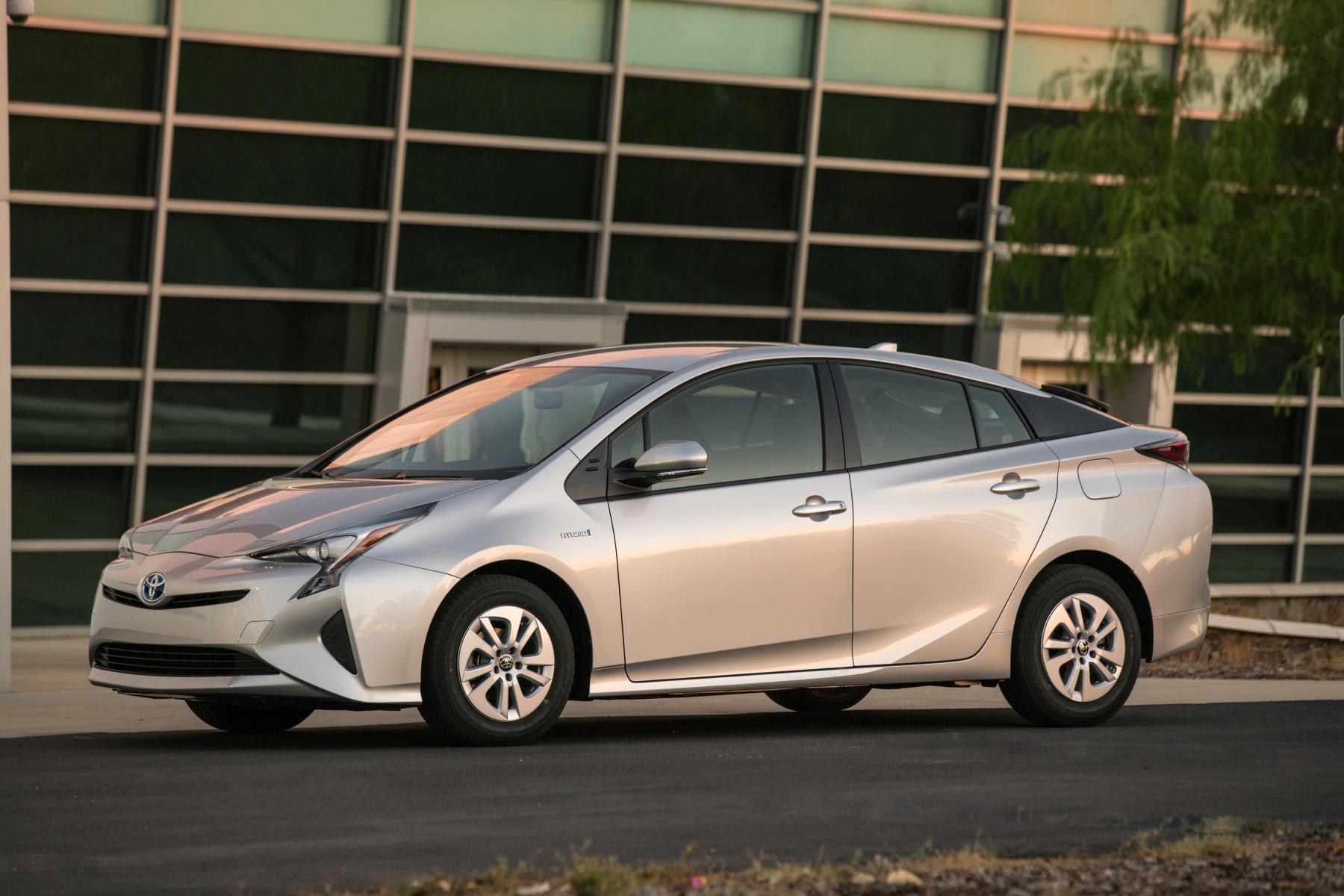
Though shaped by the wind tunnel, the Prius’s design is as much about emotion as brains. Designers imbued the new model with a greater sense of excitement. Inspired by a runner in the starting blocks, the sporty design conveys a feeling of forward motion.
The “Triangle Silhouette” that defined the second and third-generation Prius models has been reimagined. In profile, it is longer and sleeker with the overall outline evoking an athletic shape. The hood is lower, and in fact the name badge on the front is at the same height as on the Scion FR-S sports car.
The distinctive roof peak has been moved forward by 6.7 inches (170mm) to further reduce drag while still ensuring ample rear-seat headroom. Edgy character lines run along the side from the front fenders. One is just above the sill that sweeps up towards the rear fender, while the upper crease morphs into the rear spoiler. The rocker panel features a distinctive light-catching upward-facing surface that begins at the lowest part of the vehicle to highlight its stable low stance.
New standard Bi-LED headlamps dominate the Prius’ front fascia and give it an unforgettable face. Automatic headlamp leveling keeps the beam focused on the road and helps prevent blinding drivers in oncoming vehicles.
The unique and striking rear combination lamps express the distinctive lines of the Prius from the rear spoiler to the trailing edges of the sides and leave one of the most evocative nighttime signatures on the road today.
A palette of seven exterior colors includes an all-new Toyota hue, Hypersonic Red. A newly developed treatment process yields a deep and vibrant luster highlighting the external forms. Perhaps red will be the new green!
Looks Great, Less Wind Resistance
While turning heads, the new Prius design slices through the air with a 0.24 coefficient of drag (Cd), among the lowest of current production passenger cars. The sleek shape is aided by myriad details to keep the wind going on its way. An automatic grille shutter reduces drag by closing when airflow to the radiator is not needed. It remains closed after a cold start to allow the engine to reach optimal operating temperature quickly, helping to save fuel.
Aero stabilizing fins on the underfloor covers, front quarter window garnish and tail lamps likewise keep air moving in a smooth pattern. Front spats and covers on either side of the fuel tank help prevent airflow from being agitated by the tires and suspension.
High Visibility Position
The new Prius design, while sleeker than before, does not compromise driver visibility. Quite the contrary, the view to the front and sides is better than ever, starting with a lower cowl. A new pillar position and structure and larger quarter glass widen the view.
The view to the rear gets better, as well, thanks to larger rear door glass and larger fixed rear quarter windows, the latter now positioned on the rear doors. As on the previous model, a full-width glass panel beneath the rear spoiler aids rearward visibility. A backup camera comes standard on all grades. The interior rear view mirror is larger, and the exterior folding side mirrors offer a larger field of view thanks to reduced curvature. Their new shape and location also help reduce wind noise.
When “Longer, Lower, Wider” is a Good Thing
Beneath the new Prius’ dramatically styled skin lies the solid foundation of Toyota’s New Global Architecture (TNGA), an innovative and integrated approach to developing new platforms and powertrains for Toyota. In the case of the 2016 Prius, the platform introduces a new high-strength body structure, new double-wishbone independent rear suspension and low center of gravity to yield a considerably more engaging driving experience while also providing a markedly smoother and quieter ride than the previous model.
Engineered from the ground up, the new Prius is 2.4 inches longer, 0.6 inches wider and 0.8 inches lower than the model it replaces (on the same 106.3-in. wheelbase), providing a planted on-road presence while delivering more occupant and cargo room. The gasoline engine, electric motor and seating positions have been lowered to increase front and rear head room while at the same time achieving an aerodynamic, low stance.
A lower center of gravity and a more responsive suspension system, hallmarks of TNGA, dial up the driving pleasure in the 2016 Prius. That’s especially true for the Touring grade, which equips the Prius with 17-inch wheels and 215/45R17 tires and special suspension tuning. The new 17-inch wheels are 1.5 pounds lighter than those on the previous model. The light alloy 15-inch wheels on other grades are a half-inch wider than before (now 6.5 in.) and stronger, which helps reduce road noise. Aerodynamic wheel covers enhance the sporty look while catching less air. All Prius models roll on super low rolling resistance tires that are also optimized for grip.
Make a Double Wish
The promise of greater agility and sporty driving character in the 2016 Prius comes backed by a feature that defines the best sport sedans: double wishbone rear suspension. Replacing the previous torsion beam type suspension used on previous models, this new trailing-arm design greatly enhances handling, control and ride comfort and also allows increased luggage space. Soft trailing-arm bushings are tuned specifically to reduce road shock, and bushings on all arm joints reduce friction.
A Source of Strength and Calm
The more rigid structural framework of the TNGA platform also greatly contributes to the high level of handling responsiveness, steering feel and ride quality. Hot-stamped and high tensile steel, which allows for intricate forms that are both lightweight and strong, is used extensively throughout the new Prius body. More extensive use of aluminum components, including the hood and rear doorframes, keeps vehicle weight in check and also helps to reduce the center of gravity. Innovative fastening methods such as laser screw welding and advanced body adhesives help create a rigid structure.
The high strength upper body is designed to distribute frontal collision impact energy. The hood and cowl structure have been optimized for pedestrian protection in certain low speed collisions.
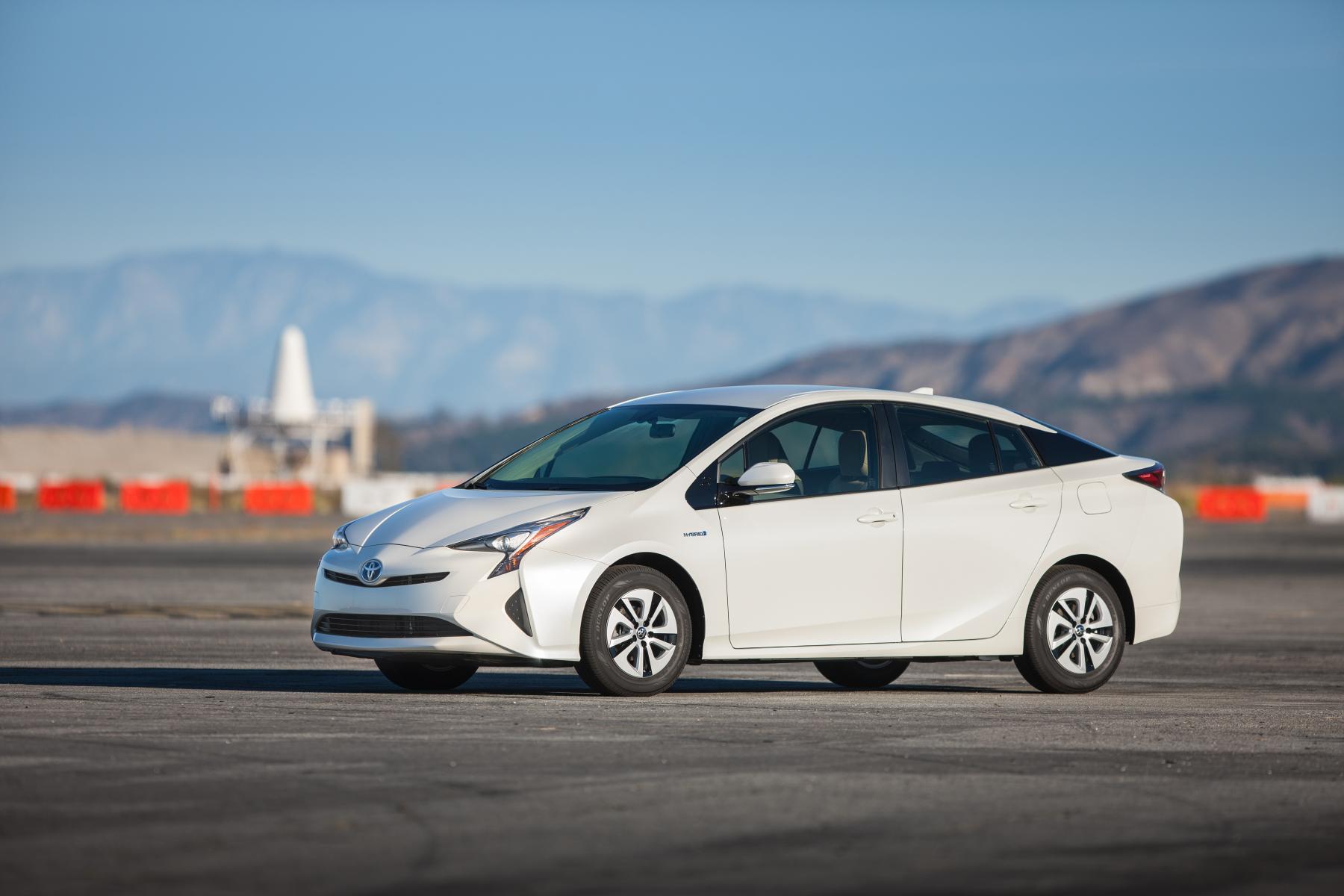
Even when it’s slowing down, the Prius conserves energy. The regenerative brake system switches the motor into a generator to recover kinetic energy of the still-turning wheels as electrical power, which is then stored in the hybrid battery.
The Electronically Controlled Brake System uses sensors to detect how much the driver is pressing the brake pedal and determines how much brake force is required from the new active hydraulic brake booster. The system coordinates control between the hybrid system’s regenerative braking and the hydraulic brake force. Brake calipers are aluminum, like on exotic sports cars.
Form and Function, Looking Good
The Toyota Prius brought not only a futuristic trend to exterior design, but also to interior configuration, delivering mid-size room in a compact package. The 2016 Prius continues the trend and is now more premium in design and feel.
The intuitive concept of former Prius generations continues, anchored by a centrally mounted gauge panel. The information displays and the center display wrap around the instrument panel, showing a layered structure. A seamless flow from the instrument panel into the door trim creates an open, airy ambience.
The soft instrument panel and trim surfaces convey a smooth, warm feel. High-contrast interior colors available include Moonstone Gray, Harvest Beige and Black. Accents on the side air vents and seat stitching, available in three colors depending on model grade, heighten the more emotive feel of the cabin. Features that drivers use on a regular basis, including a new electric fuel lid release, are placed close to hand for intuitive operation. The look may seem futuristic, but the driver does not need an advanced degree to use the controls.
Information Central
In the 2016 Prius, the electronic information cluster appears to float through a carefully carved, almost invisible rear surface. The new panel features dual 4.2-inch full-color TFT (Thin Film Transistor) multi-information displays, and their content can be changed using steering wheel controls. To suit the mood, the display background color changes depending on selected driving mode. Choose Power mode, and the background becomes racy red. Select Normal mode for a soothing blue glow.
The display provides a multitude of readouts for hybrid energy information and much more, but best of all, the driver can choose how much information to receive by selecting either Simple or Segmented display modes.
Simple mode shows a large vehicle speed display, remaining fuel, drive mode indicator, outside temperature, odometer functions and cruising range. The Segmented display presents more detail about hybrid operation, including instantaneous fuel economy, hybrid battery state of charge and a suite of ECO functions to encourage efficient driving habits. An ECO Score function grades the driver’s efficiency performance; ECO Wallet displays the total gasoline cost and gasoline cost savings for a single trip, and by month; ECO Diary records and displays driving history, and ECO Accelerator Guidance helps coach the driver to drive in a more fuel-efficient manner.
A driving support display shows the status of features such as radar cruise control, Lane Departure Alert and other systems. The driver can cycle through the Multi-Information Display content using steering wheel-mounted switches. After the vehicle is turned off, the display will remain on for 30 seconds to show elapsed time, distance traveled, average fuel economy, Eco Score result, and driving advice to help enhance fuel economy.
Noise Controlled
The most critical element of the new Prius interior becomes apparent only once underway: quietness. With a lighter, more efficient hybrid system and greater usage of high-strength, light-weight body materials, Toyota was able to significantly increase noise control measures without hurting the vehicle’s fuel economy or performance.
New noise-control features and materials throughout the body, engine compartment and cabin combine to give the 2016 Prius a serene passenger cabin. A sound-insulating laminated windshield glass and numerous new sound absorbers in the dash structure reduce noise intrusion. Higher-grade models feature sound-insulating laminated front door glass, as well.
Below the carpeting lies a significantly thicker floor silencer pad. Above the occupants, a urethane-based headliner, along with the ribbed structure of the front pillar trim, helps absorb sound. No detail was too small to escape attention. For example, labyrinth-style clips in the door drain holes prevent sound from intruding yet still facilitate drainage. Above the occupants, a urethane-based headliner and the ribbed structure of the front pillar trim helps absorb sound.
Attention to the outer body surfaces reduces wind noise at the sources, such as adding rain gutter moldings next to the windshield and improving the transition between the windshield glass and front pillar.
Cocoon of Comfort
The 2016 Toyota Prius may be the most comfortable way to conserve fuel. Amenities abound in this roomier, quieter model, with comfort and convenience manifesting in many details. Take the tilt and telescoping steering wheel, for example. Depending on model grade, it comes wrapped in urethane or SofTex® synthetic leather. The synthetic leather features surface temperature-regulating properties to make it feel more comfortable in hot or cold weather.
The air conditioning system uses a new, quieter electric compressor, and the Smart-flow (S-FLOW) mode focuses airflow only to areas where occupants are seated in order to help maximize fuel economy and comfort. The system’s slim climate control panel conveys a luxurious feel with piano black finish for the switches and chrome accents. Each control is arranged directly underneath its corresponding display, for intuitive operation.
A pollen-eliminating cabin air filter comes standard. In the Prius Eco grade, heat-insulating IR-cut windshield glass substantially reduces transmission of infrared rays to help ensure a comfortable cabin, especially in the summer. It also reduces the air conditioning system workload, which helps to save fuel. In cold weather, a positive temperature coefficient ceramic heater warms the cabin quickly without relying on the engine coolant to come up to operating temperature.
In Tune With Entune®
The Prius comes ready to connect with your world through its Entune Audio systems. The Entune Audio system standard on Prius Two and Prius Two Eco grades includes the Entune Multimedia Bundle (6.1 in. touch-screen display, AM/FM CD player, six speakers, auxiliary audio jack, USB 2.0 port with iPod®connectivity and control, advanced voice recognition, hands-free phone capability, phone book access and music streaming via Bluetooth® wireless technology), plus Siri® Eyes Free mode and an integrated backup camera display.
On all other grades, the standard Entune Premium Audio with Integrated Navigation system and Entune App Suite® includes all of those features plus a seven-inch high resolution touch-screen with split screen display, Entune App Suite, HD radio, HD predictive traffic and Doppler weather overlay, AM/FM cache radio, SiriusXM All Access Radio with 3-month complimentary trial and Gracenote album cover art.
As part of a package, the Prius Four grade exclusively offers the Entune Premium JBL® Audio system with Integrated Navigation and App Suite. To all features of the base and middle systems, it adds 10 JBL GreenEdge™ speakers in eight locations.
The Entune® App Suite – includes Destination Search, iHeartRadio, MovieTickets.com, OpenTable®, Pandora®, Facebook Places, Yelp™ and Slacker Radio plus real-time info including traffic, weather, fuel prices, sports and stocks. Access to Entune® services is subscription free.
If you’ve got Qi-compatible devices (regardless of model or manufacturer), leave the charging cords at home, because the 2016 Prius offers a wireless charging system. Simply place a compatible device on the console pad to initiate charging.
New Toyota Safety Sense
The high-strength Prius cabin is enhanced for occupant protection in a collision, while inside, a full array of supplemental restraint system (SRS) airbags includes multi-stage driver and front passenger SRS dual-stage front airbags; driver and front passenger SRS side airbags; full-length SRS curtain airbags; a driver SRS knee airbag, and a front passenger SRS seat cushion airbag.
The 2016 Prius is one of the first Toyota models to offer Toyota Safety Sense P, an innovative package of driver assist technologies that, under certain conditions, can detect obstacles and automatically apply braking if necessary to help avoid collisions. The system employs new millimeter-wave radar and a monocular camera sensor to detect pedestrians, vehicles, and lane markers in the surrounding area.
Toyota Safety Sense includes the following functions to support collision avoidance or driving operations:
- Pre-collision System (PCS) with Pedestrian Detection (PD)
- Lane Departure Alert (LDA) with Steering Assist (SA)
- Automatic High-beam (AHB
- Full-Speed Dynamic Radar Cruise Control (DRCC); works in stop and go traffic down to a full stop.
More Tech, Greater Peace of Mind
Parking doesn’t get much easier than with available Intelligent Parking Assist (IPA), another technology making its debut outside of Japan. A simple system design using only ultrasonic wave sensors, IPA is activated by the driver to offer automatic steering into parallel parking spaces, or reversing into perpendicular spaces. The system also offers automatic steering to exit a parallel space.
An additional function of the sonar-based Park Assist system, the Toyota-first Intelligent Clearance Sonar provides visible and audible warnings if the driver gets too close to obstacles on the vehicle’s sides. An indicator on the Multi-information Display shows the obstacle’s location, and a warning is issued only when the system judges that there is a possibility of contact with the obstacle.
Value Pricing
The manufacturer’s suggested retail price (MSRP) for the 2016 Prius will range from $24,200 for the Prius Two model to $30,000 for the Prius Four Touring.
The MSRP for all Prius models does not include the delivery, processing, and handling (DPH) fee of $835. The DPH fee for vehicles distributed by Southeast Toyota (SET) and Gulf States Toyota (GST) may vary.
Peace of Mind Warranty Protection
Toyota’s 36-month/36,000 mile basic new-vehicle warranty applies to all components other than normal wear and maintenance items. Additional 60-month warranties cover the powertrain for 60,000 miles and against corrosion with no mileage limitation. The hybrid-related components, including the HV battery, battery control module, hybrid control module and inverter with converter, are covered for eight years/100,000 miles. In applicable states hybrid-related component coverage is 15 years/150,000 miles with the exception of the hybrid battery, which is covered for 10 years/150,000 miles.
The Prius also comes standard with Toyota Care, a complimentary plan covering normal factory-scheduled maintenance for two years or 25,000 miles, whichever comes first. And, exclusive for Prius, three years (over the normal two) of 24-hour roadside assistance.
2016 Prius Pricing
| Model # | Model | Body Style | Transmission | Grade | MSRP |
| 1223 | Prius | Hatchback | CVT | Two | $24,200 |
| 1224 | Prius | Hatchback | CVT | Two Eco | $24,700 |
| 1225 | Prius | Hatchback | CVT | Three | $26,250 |
| 1226 | Prius | Hatchback | CVT | Three Touring | $28,100 |
| 1227 | Prius | Hatchback | CVT | Four | $28,650 |
| 1228 | Prius | Hatchback | CVT | Four Touring | $30,000 |

